Overview
For my final project, I wanted to create a magnetic shoe display that blends futuristic levitation technology with a handcrafted, organic wood aesthetic. My inspiration stemmed from a standard design I found repeatedly online: a sleek, U-shaped black frame with an integrated LED strip illuminating the suspended shoe. The aesthetic of these displays is minimalistic and high-tech, often relying on symmetry, smooth acrylic surfaces, and modern lighting to create a luxury feel. One example is the Luxury Style 360° Rotation Magnetic Floating Shoe Stand, which set a benchmark for levitating functionality but left little room for individuality or material warmth [1]. I saw an opportunity to reinterpret this concept by bringing in materials and forms that felt more natural and sculptural.
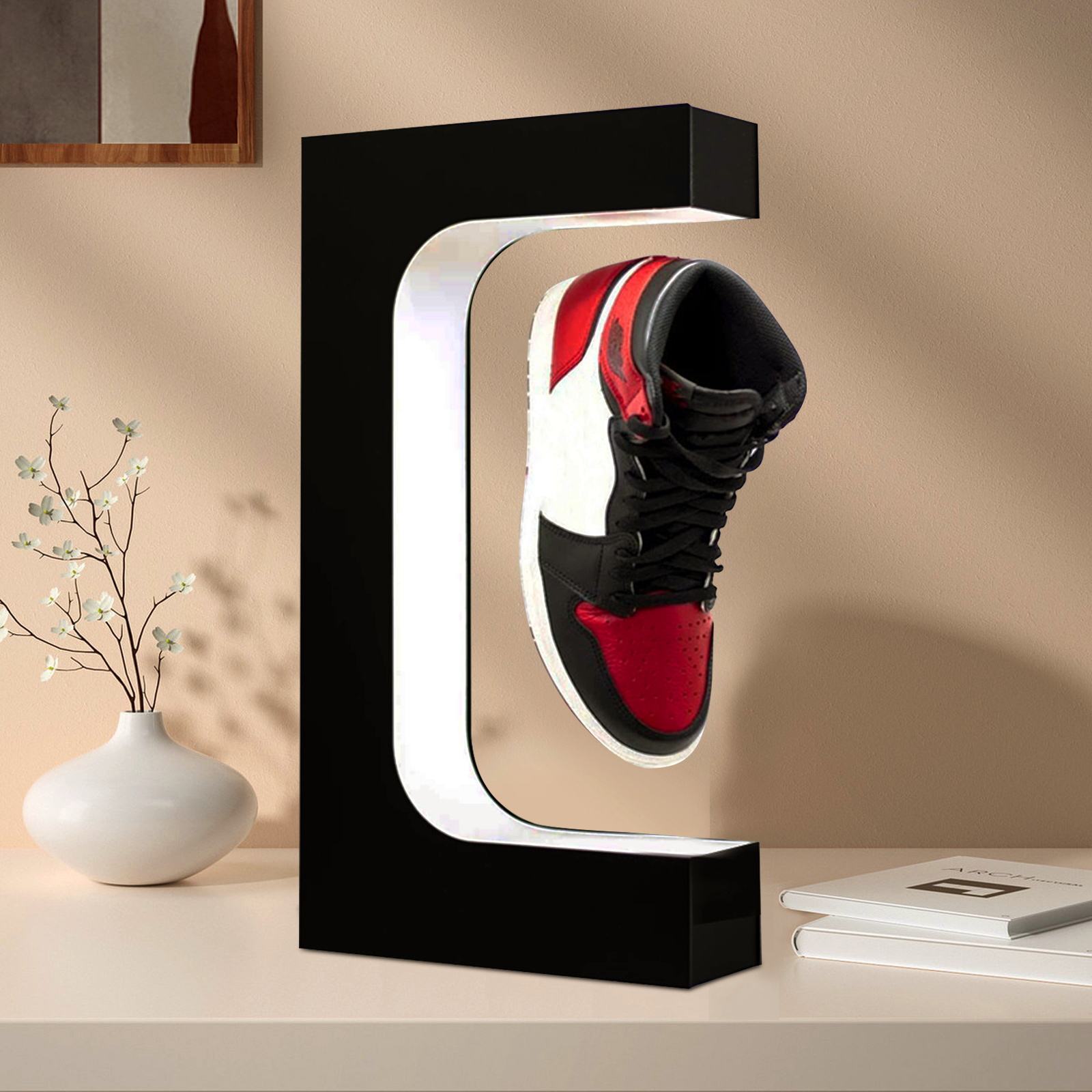
[1] Luxury Style 360° Rotation Magnetic Floating Shoe Stand
The idea was to retain the core functionality of these existing designs—the shoe’s magnetic levitation—while reimagining the entire visual language around it, specifically the base. Rather than using polished plastics and sterile shapes, I wanted the base carved from wood, emphasizing natural textures and flowing forms. In doing so, I could combine the almost technological aspect of magnetic levitation with a rustic, grounded, and tactile material. This contrast became central to my aesthetic vision: combining engineered function with an earthy, crafted form that could live comfortably in a home or gallery without looking like tech hardware.
Inspiration Online
When researching materials and techniques that could help realize this vision, I was drawn to power carving. I came across examples of woodworkers sculpting fluid, naturalistic shapes from large wood blocks using angle grinders and carving discs. Tutorials on YouTube [2][3] and projects from Blacktail Studio [4] offered compelling demonstrations of how raw lumber could be shaped into seamless, organic forms. These examples reinforced that the carved wood base could feel more like a sculptural art piece than a mass-manufactured product. I was especially taken with pieces that embraced the wood’s natural grain and let the lines flow across curved surfaces, which helped me understand how material and form could work in tandem.
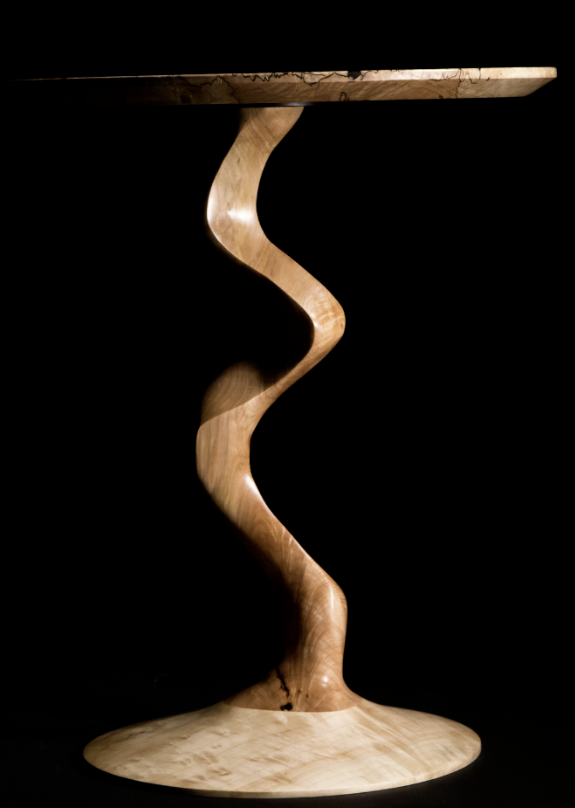
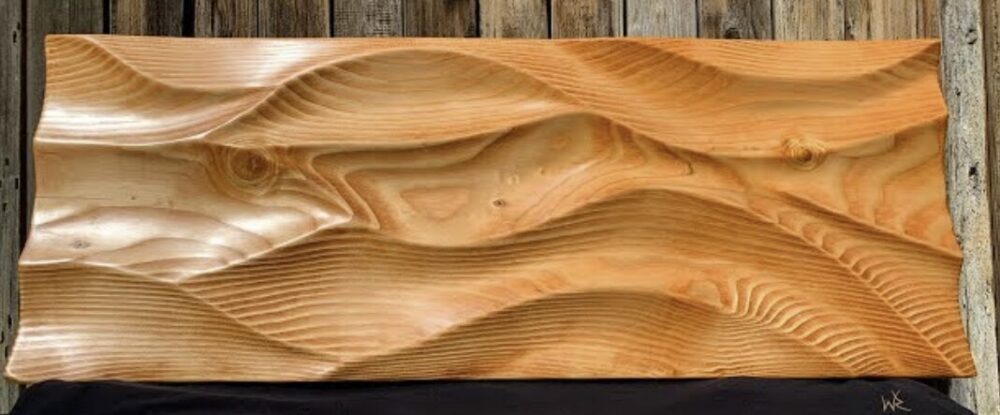
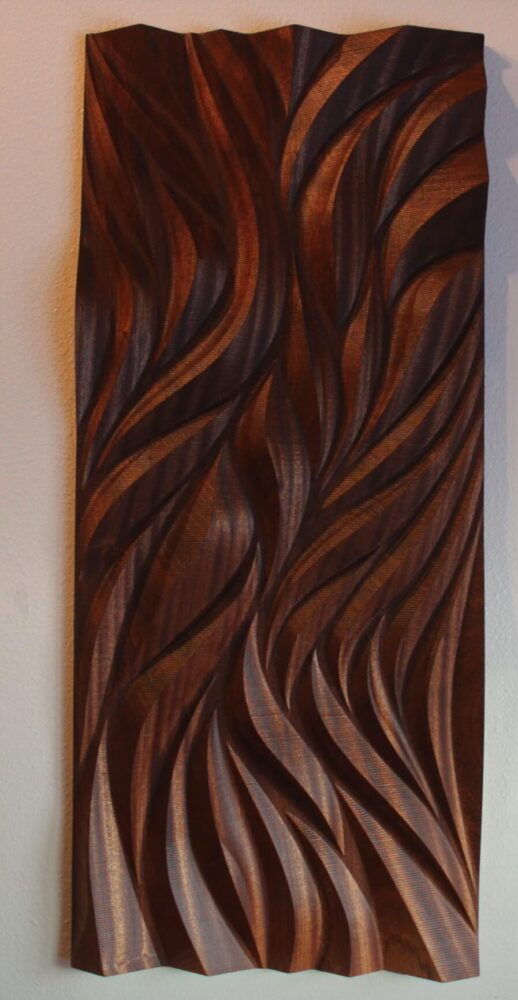
[4] Black Tail Studio [3] Angle Grinder Wood Carving [2] Power Carving
From the start, I had a strong vision for the overall form of the base. I imagined it as a continuous loop, flowing from a root-like bottom structure to an upper arch that visually surrounds the shoe. I gained a lot of inspiration from this YouTube video of someone who made a levitating shoe display from sheets of plywood and paint [5]. My initial sketches [6] reflect this inspiration and explore this idea through different shapes—some geometric, some more topographical and organic. I experimented with layering, thinking through how stacked plywood could be cut and shaped to create contours. One early sketch had a layered heatmap look, inspired by topography and landscape forms. This concept evolved further when a classmate suggested I integrate the Nike logo into the structure, which led to a design where the base looked like a tree trunk and the shoe grew out of it like a branch. The final sketch [7] fully realizes this idea: the flowing base wraps around and lifts the shoe, with a carved channel for lighting embedded below.
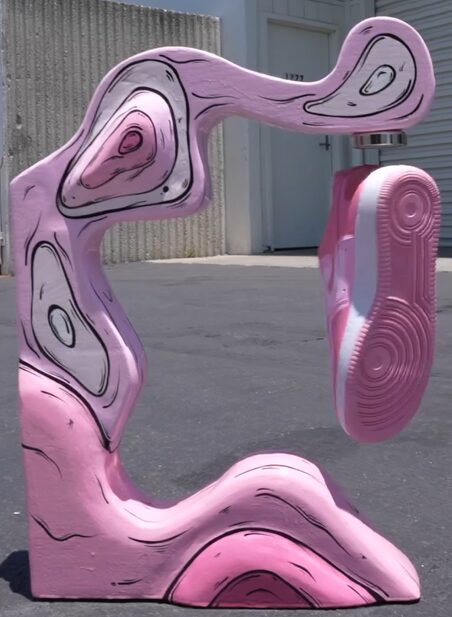
[5] Levitating shoe display: Initial Inspiration

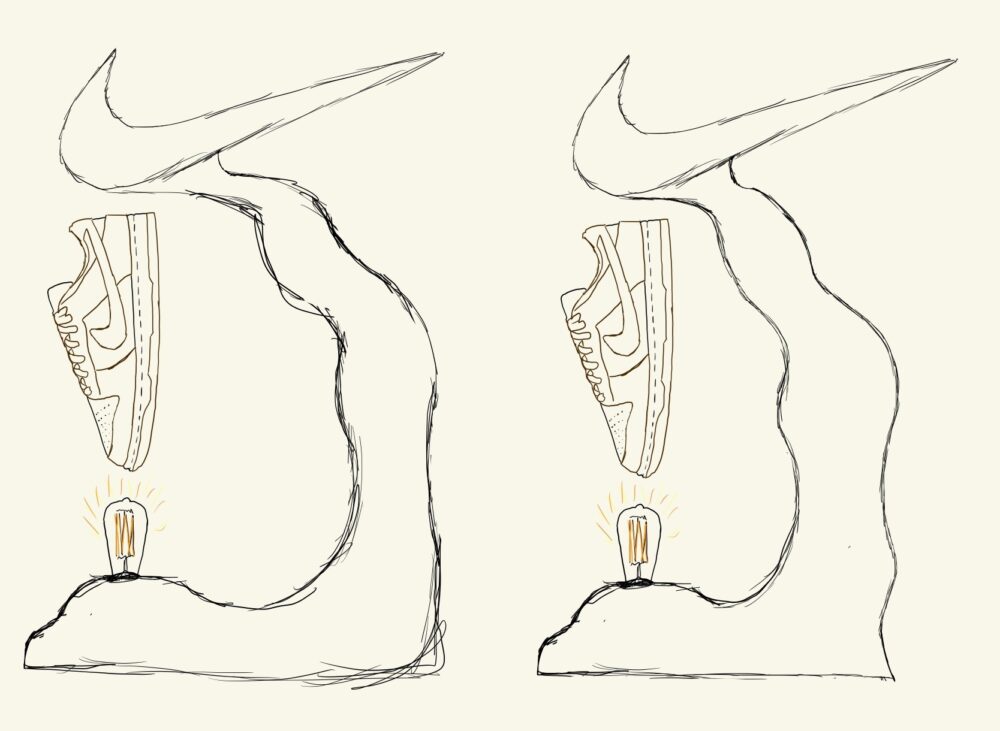
[6] Initial Sketch [7] Final Sketch
The specifications for my design were guided by four principles: cohesive form, organic shaping, visual and functional integration, and durability. I wanted the base to appear as though it was carved from a single piece of wood—an unbroken, unified object. This meant minimizing visible seams, ensuring all transitions between carved layers felt smooth and intentional. At the same time, the form needed to feel natural and fluid, as if it had grown rather than been manufactured. I didn’t want harsh geometry or mechanical shapes. Instead, I leaned into asymmetry, curves, and irregularity that mimicked the organic evolution of a tree root or eroded stone.
Equally important was the idea of integration. The lighting source, for instance, was not meant to look like an add-on but rather something embedded within the wood itself. I selected an Edison bulb for its warm tone and vintage aesthetic, contrasting beautifully with the high-tech levitation but harmonizing with the natural wood grain. The bulb sits in a carved recess at the base and shines upwards, illuminating the shoe in a soft glow. Its light wraps around the contours of the floating object, casting shadows that enhance the sculptural quality of the display. I deliberately avoided the LED strip that most magnetic displays use, as I wanted a warmer and more analog feel to the lighting. The magnet system, too, was chosen and configured to be completely flush with the sculpture, allowing the shoe to appear as if it were suspended by magic, without visible support.
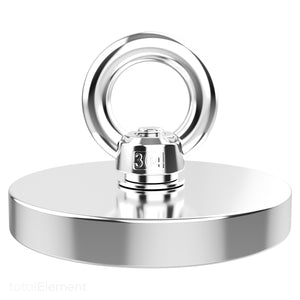
[8] Edison Bulb [9] Magnet
Function
Functionally, the display needed to do more than look good; it had to work reliably. Ideally, the shoe must float above the base with a noticeable gap and the potential to rotate slowly. To achieve this, I tested several magnetic setups. While many commercial versions use electromagnets and active stabilization systems, I began with neodymium magnets and steel balls, as seen in DIY models online. After several iterations and testing different strengths and placements, I found a configuration that provided a strong enough lift without snapping or instability. The goal was to make the levitation feel effortless and smooth, while ensuring the shoe was secure enough not to fall from a light bump or vibration.
Material
Material selection significantly affected the piece’s aesthetic and structural integrity. Initially, I wanted to use walnut or maple for their tight grain and rich tone. However, given my tooling constraints, their high cost and density made them challenging. I settled on pine wood—a more affordable softwood with a pleasant grain pattern and better carving properties. To reduce waste and keep the budget in check, I used sheets of ¾-inch pine s4s boards, cutting each layer by hand with a jigsaw. While cutting identical layers manually proved challenging, I embraced the slight irregularities in shape and grain pattern as part of the organic charm. Each layer was glued and clamped carefully, then carved to form a unified surface. Though I couldn’t access advanced tools like a flush-trim router or planer, the project came together through patience and deliberate shaping.
The process of shaping and finishing the wood was both challenging and rewarding. Using an angle grinder and carving disc, I sculpted the laminated block into its final flowing shape. The grain of each wood layer created natural striations that enhanced the organic feel of the base. After carving, I smoothed the surface with progressively finer sandpaper, finishing with a stain and polyurethane layer to protect the surface. To maintain a clean look, I hid seams and hardware wherever possible. The bulb socket was countersunk into the base, and the wiring was routed discreetly so as not to interfere with the clean, uninterrupted silhouette of the stand.
Conclusion
The final display synthesizes all these ideas—a functional levitating stand that feels handcrafted and futuristic. The effect is striking when the shoe is suspended above the base and lit from below. The warm glow of the Edison bulb highlights the curves of both the shoe and the wood, creating a floating visual centerpiece that feels both modern and timeless. It achieves my original intent: to reinterpret a high-tech display through the lens of traditional craftsmanship and natural materials.
This project allowed me to explore new techniques, from power carving to magnet configuration, while deepening my appreciation for how design choices affect function and emotional resonance. Rather than building something that felt cold and mechanical, I wanted the display to evoke curiosity and warmth. It’s a piece that invites closer inspection—not just because a shoe is floating, but because the base tells a story. From the layered wood boards to the gentle curves and grain patterns, every part of the design supports the illusion and enhances the object on display. In blending technology and craft, I created something unique, personal, and grounded in form and function.
References
[1] Best Suppliers. “Luxury Style 360° Rotation Magnetic Floating Shoe Rotating Display Stand.” Best Suppliers, https://www.bestsuppliers.com/products/pjdq24guhaoh/luxury-style-360-rotation-magnetic-floating-shoe-rotating-display-stand-magnetic-levitation-acrylic. Accessed March 6, 2025.
Used as reference image for standard commercial levitating shoe display aesthetic.
[2] “Angle Grinder Wood Carving.” YouTube, uploaded by [User/Channel Name], 13 Mar. 2025, https://www.youtube.com/watch?v=nWnRg9dnLBY.
Used for inspiration and reference on power carving techniques.
[3] “Power Carving with an Angle Grinder.” YouTube, uploaded by [User/Channel Name], 13 Mar. 2025, https://www.youtube.com/watch?v=JaJb-JcX3GQ.
Visual reference for wood shaping techniques and organic form carving.
[4] Blacktail Studio. “Power Carving Wood with an Angle Grinder Using Scrap Wood.” Blacktail Studio, March 13, 2025, https://www.blacktailstudio.com/blog/power-carving-wood-angle-grinder-with-scrap-wood.
Used for inspiration on the aesthetic potential of carved wood.
[5] MARKO. Levitating Shoe Display [Video]. YouTube, July 5, 2023, https://www.youtube.com/watch?v=dHRH4WpnY1U.
Used for visual reference of floating shoe setup with magnet.
[6] Initial Sketches and Design.
[7] Final Sketch and Design
[8] Feit Electric. 100-Watt Equivalent ST19 Dimmable Straight Filament Amber Glass E26 Vintage Edison LED Light Bulb, Warm White 3000K (ST19100/LED/HDRP). The Home Depot, https://www.homedepot.com/p/Feit-Electric-100-Watt-Equivalent-ST19-Dimmable-Straight-Filament-Amber-Glass-E26-Vintage-Edison-LED-Light-Bulb-Warm-White-3000K-ST19100-LED-HDRP/313397561. Accessed March 12, 2025.
Used as the primary light source to enhance the warm, rustic aesthetic of the wood base.
[9] “Neodymium Cup Magnets, 800LBS.” Amazon, https://www.amazon.com/gp/product/B0D73FHCKK. Accessed March 12, 2025.
Used as the magnetic levitation mechanism for suspending the shoe.
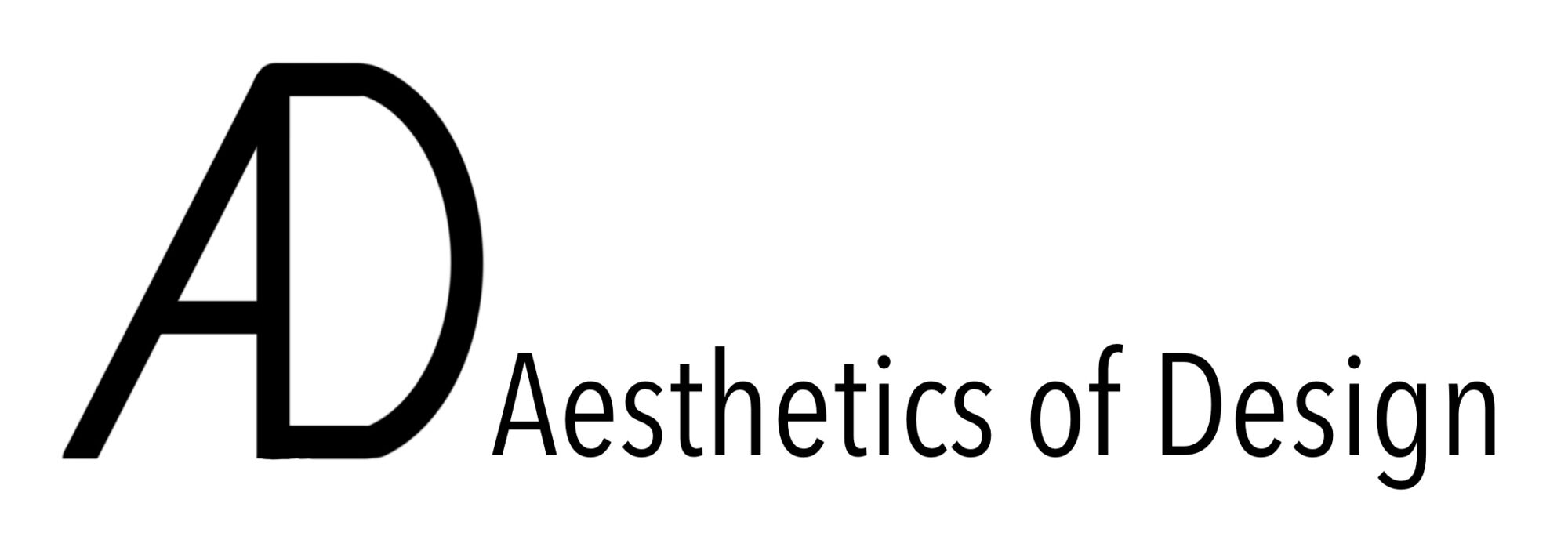
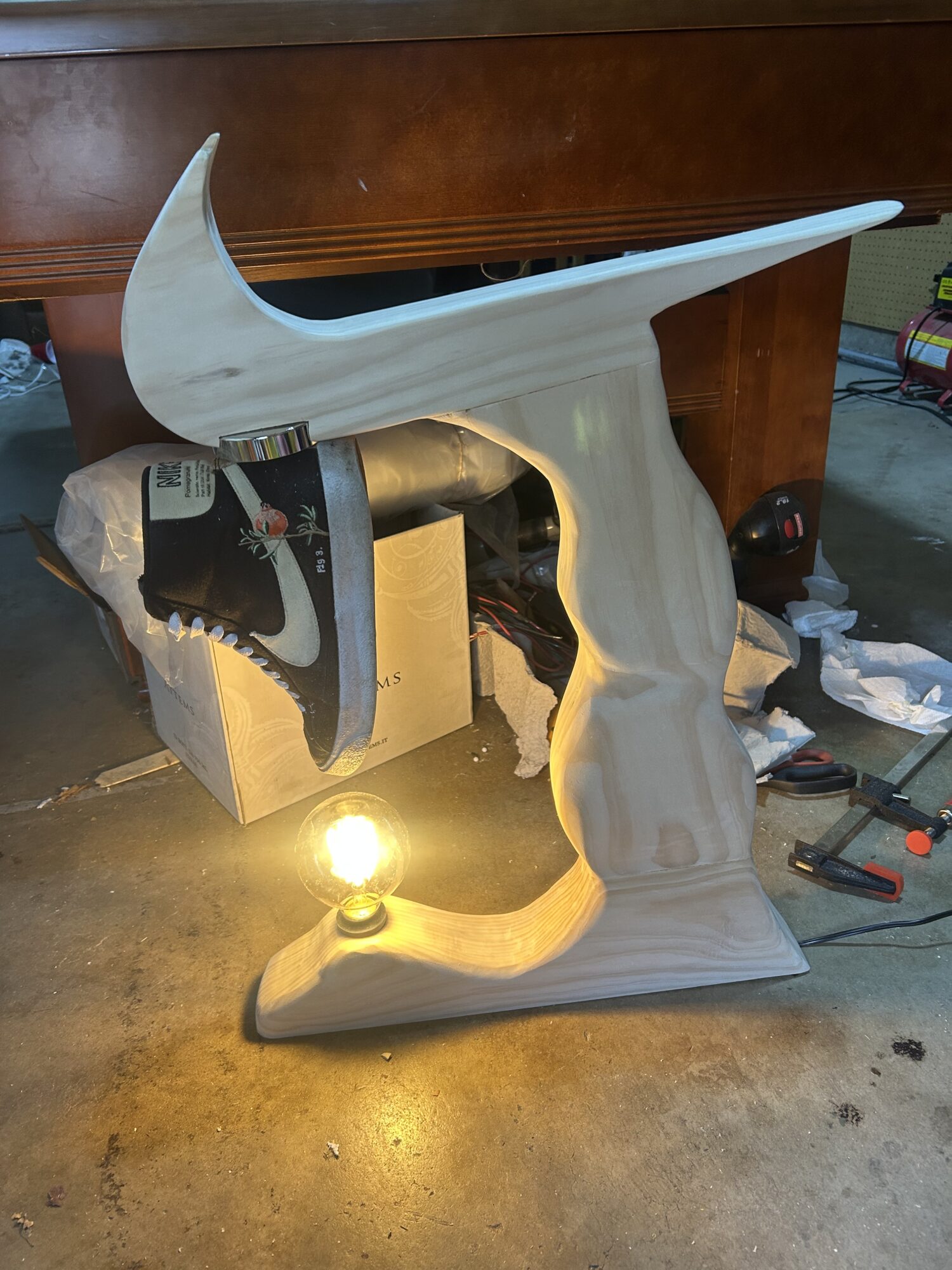
2 Comments. Leave new
Hello,
Based on the images, I feel that you did a great job on this project. I think you really captured an organic shape, and the base of the display showcases these organic forms beautifully. They remind me a lot of carving through rubber linocut blocks used for ink patterns or art making.
You were able to accurately represent the Nike shoes within your design, and the incorporation of light really helps illuminate the shoe. It might be possible to use an LED that produces a similar warm light, wrapped in a diffusive layer to prevent the light from diminishing and spreading too much. However, I feel that using a bulb could risk burning your shoe over time, but I’m not entirely sure about that.
Either way, I like how your inspiration came together in your final design.
Hi James,
Great work on this project! You really captured the organic, root-like shape you were going for, and this contrasts great with the clean lines of the Nike Swoosh. The light looks really nice, and really helps to illuminate the shoe. One suggestion that I have would be to use a darker stain to maybe help emulate the walnut look you were initially considering, and help to add some contrast to the yellow light of the Edison bulb. Great job on this project, I’m really looking forward to seeing more about your power carving process!